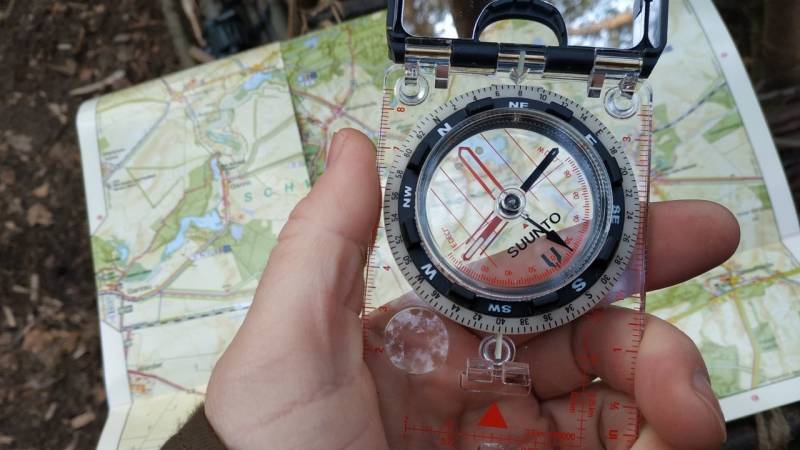
Navigation
Substantiv/Nomen
Meaning
Navigation is a crucial skill in the world of survival, bushcraft, and outdoor activities. It refers to the ability to find one's way and navigate through unfamiliar terrain using various tools and techniques. In the context of survival, navigation involves using a compass, map reading, and orienteering to determine direction and reach a desired destination. It is essential for hikers, campers, and adventurers to have a solid understanding of navigation to avoid getting lost and ensure their safety. By mastering navigation skills, you can confidently explore the wilderness and navigate your way back home.

Examples
„I love exploring the wilderness and practicing bushcraft, but one skill that is absolutely crucial for survival is navigation. Whether you're hiking in the mountains or trekking through dense forests, knowing how to navigate your way is essential.“
„Imagine you're deep in the woods with no GPS or cell phone signal. You rely solely on your compass and map to navigate through the wilderness.“
„As I was teaching a group of outdoor enthusiasts, I emphasized the importance of navigation skills. I explained how to use landmarks and natural features to orient yourself and find your way back to camp.“
„During a recent camping trip, my friend and I got caught in a heavy fog. With limited visibility, we had to rely on our compass and compass bearings to navigate safely back to our campsite.“
„When I go on solo expeditions, I always make sure to pack a reliable GPS device. It not only helps me track my progress but also provides accurate coordinates for navigation.“
„Navigation is not just about finding your way from point A to point B; it's about understanding your surroundings, reading the landscape, and making informed decisions. It's a skill that every outdoor enthusiast should master.“
Origin
The word "navigation" originates from the Latin word "navigatio", which means "sailing" or "voyaging". It has its roots in the ancient practice of using celestial bodies, such as the stars, to determine direction and location while at sea.
Over time, navigation techniques evolved and became more sophisticated. In the 18th century, the invention of the marine chronometer by John Harrison revolutionized navigation by allowing sailors to accurately measure longitude. This development greatly improved the safety and efficiency of sea travel.
In the modern era, navigation has expanded beyond just maritime use. With the advent of technology, tools like compasses, maps, and GPS systems have made navigation accessible to everyone, whether on land, in the air, or at sea.
Today, navigation plays a crucial role in various fields, including aviation, hiking, and, of course, survival. It enables us to find our way in unfamiliar terrain, avoid getting lost, and reach our desired destinations safely.
Synonyms
Orientation, Direction, Guidance, Wayfinding, Map reading, Compass use, Charting, Plotting
Antonyms
Lost, Disoriented, Directionless, Confused, Off course, Wandering, Astray, Misguided
Relatives
Compass, Map, GPS, Orienteering, Wayfinding, Coordinates, Landmarks, Celestial navigation
Historical and cultural importance
Navigation is a crucial skill in the world of survival and outdoor adventure. Throughout history, humans have relied on various methods of navigation to explore and navigate their surroundings. From ancient civilizations to modern explorers, the ability to navigate accurately has played a significant role in human survival and discovery.
One of the earliest forms of navigation was celestial navigation, which involved using the stars, moon, and sun to determine direction and location. This method was widely used by ancient seafarers and explorers, allowing them to navigate vast oceans and discover new lands.
In addition to celestial navigation, land-based navigation techniques have also been developed over time. In the past, people relied on natural landmarks, such as mountains, rivers, and trees, to find their way. They would create mental maps and use their observations of the environment to navigate through unfamiliar territories.
With the advancement of technology, navigation tools have become more sophisticated. The invention of the compass revolutionized navigation, providing a reliable method for determining direction. Today, we have GPS devices and navigation apps that use satellite signals to pinpoint our exact location and guide us to our destination.
Understanding the historical and cultural significance of navigation helps us appreciate the importance of this skill in survival situations. It reminds us of the ingenuity and resourcefulness of our ancestors, who relied on their knowledge of the natural world to navigate and explore. Whether you're hiking in the wilderness or embarking on a long-distance journey, having a solid understanding of navigation techniques is essential for your safety and success.
More information about the term Navigation
Navigation
Navigation is a crucial skill for anyone venturing into the wilderness. Whether you're hiking, camping, or engaging in survival activities, knowing how to navigate effectively can mean the difference between getting lost and finding your way back to safety. In this article, I'll cover some essential navigation techniques and tools that will help you stay on track in the great outdoors.
Map Reading
One of the fundamental skills in navigation is map reading. A topographic map provides a detailed representation of the terrain, including elevation, water sources, and landmarks. By understanding how to interpret a map, you can determine your location, plan your route, and identify potential hazards.
Start by familiarizing yourself with the map's key and symbols. This will help you understand the various features represented on the map. Next, locate your current position by using identifiable landmarks or by triangulating your position using known landmarks. Once you know where you are, you can plot a course to your destination and navigate using compass bearings or by following prominent terrain features.
Compass Navigation
A compass is an essential tool for navigation. It allows you to determine your direction and maintain a consistent heading. To use a compass, hold it level and away from any metal objects that could interfere with its accuracy. Align the compass needle with the orienting arrow and rotate the compass housing until the north end of the needle aligns with the north arrow on the housing.
Once your compass is properly aligned, you can determine your direction of travel. Hold the compass in front of you and turn your body until the orienting arrow aligns with the north end of the needle. The direction of travel arrow on the compass housing will now point in the direction you need to go.
Using Natural Navigation
In addition to using maps and compasses, you can also rely on natural navigation techniques. Observing the sun, moon, and stars can help you determine your direction during the day and at night. The sun rises in the east and sets in the west, providing a reliable reference point. The moon and stars can also be used to navigate, with certain constellations serving as reliable markers.
Another natural navigation technique is using terrain features. By observing the shape of the land, you can identify prominent landmarks and use them as reference points. Mountains, rivers, and valleys can all help you stay oriented and navigate effectively.
Conclusion
Navigation is a vital skill for anyone spending time in the wilderness. By mastering map reading, compass navigation, and natural navigation techniques, you can confidently explore the great outdoors while staying safe and on track. Remember to always carry a map and compass with you, and practice your navigation skills regularly to maintain proficiency. With these skills in your toolkit, you'll be well-equipped to navigate any wilderness adventure.
Back to overview

